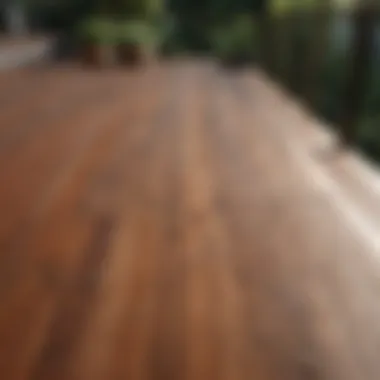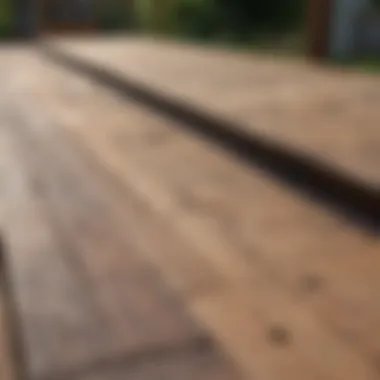Understanding the Average Cost to Install a Deck


Intro
The cost of deck installation varies depending on several factors. These include the type of materials used, the complexity of the design, the cost of labor, and geographic location. Each element can impact the overall expenditure significantly. By gaining insights into these factors, homeowners can make informed decisions that align with their financial and aesthetic preferences.
This article delves into various aspects influencing deck installation costs. It aims to equip readers with the knowledge needed to plan effectively and avoid unexpected financial burdens.
Preface to Deck Installation Costs
When considering a deck installation, understanding the costs involved can significantly influence your decision-making process. Decks offer both aesthetic appeal and functional living space, so knowing the average cost to install one is crucial for budgeting and planning. This section will explore why comprehending these costs is not just beneficial but essential for homeowners and design enthusiasts alike.
Overview of Deck Installation
The process of deck installation involves various elements that interact to determine the final expense. These elements range from the materials chosen, the design and complexity of the project, to labor costs and local regulations. A clear understanding of these factors enables homeowners to set realistic expectations.
- Material Selection: Different materials have distinct costs associated with them. For instance, wood, composite, and aluminum decks have very different price ranges and lifespans.
- Size and Design: The scale and intricacy of the deck can greatly influence the overall price. A larger, more intricate deck will naturally require more materials and labor.
- Labor Costs: Hiring professionals may come at a premium, but the investment often pays off in quality of work and lasting appeal.
- Location: Geographic factors can impact not just material availability but also labor rates. The local market conditions play a pivotal role in determining the financial blueprint of your project.
Understanding installation costs allows potential deck owners to allocate their budgets wisely. As we delve into specific topics, readers will gain insights into how each factor contributes to the overall expense, enabling informed choices tailored to their unique needs.
Material Choices and Their Impact on Cost
When planning for a deck installation, one of the most pivotal decisions involves selecting the materials. The type of materials you choose greatly influences not only the overall aesthetic and functionality of your deck but also the project’s cost. Different materials come with unique properties, advantages, and drawbacks, making it essential for homeowners to evaluate each option carefully.
Wood Decking Options
Wood is a classic choice for decking due to its natural appearance and warmth. There are various types of wood available, such as pressure-treated pine, cedar, and redwood. Each type offers distinct characteristics that can impact cost:
- Pressure-Treated Pine: Typically the most affordable option, pressure-treated pine is durable and resistant to rot and insects. However, it requires regular maintenance, such as staining and sealing, to prolong its lifespan.
- Cedar and Redwood: These woods are naturally resistant to decay and possess beautiful grain patterns. They are more expensive than pressure-treated pine. However, they tend to last longer without extensive maintenance.
- Exotic Hardwoods: Species like Ipe and Teak are very durable and can last decades. They can be significantly more expensive than common softwoods.
While wood decking can provide a traditional look, it usually needs more care and may have higher long-term maintenance costs, which is something to consider when budgeting.
Composite Decking
Composite decking has gained popularity among homeowners for its durability and low maintenance. Made from a blend of wood fibers and recycled plastics, composite materials are designed to mimic the appearance of wood while providing enhanced resistance to fading, scratching, and mold. Some key benefits and costs include:
- Cost: Composite decking can be more expensive upfront compared to traditional wood; however, it often requires less maintenance over time, reducing long-term costs.
- Durability: Composite decks can last significantly longer, ranging from 25 years to lifetime with proper care. This longevity can offset the initial investment.
- Variety: Available in numerous colors and textures, homeowners can select a design that fits their aesthetic preferences while ensuring longevity.
Overall, while the initial cost is higher, composite decking can be seen as cost-effective given its lifespan and minimal upkeep requirements.
PVC Decking
PVC decking is fully synthetic, meaning it contains no organic materials. This type of decking offers several advantages:
- No Maintenance: Unlike wood, PVC doesn’t need regular staining or sealing. This can lead to lower maintenance costs over time.
- Water Resistance: PVC is highly resistant to moisture, making it ideal for areas with high humidity or exposure to water.
- Color Retention: It resists fading from UV rays, which helps maintain its vibrant colors without the need for regular upkeep.
However, PVC decking typically falls within the higher price range, and homeowners need to weigh these costs against the long-term savings on maintenance.
Aluminum Decking
Aluminum decking is another option gaining traction due to its strength and durability. Some of its key features include:
- Longevity: Aluminum is exceptionally durable and resistant to weather, corrosion, and pests. It can last a lifetime when properly installed.
- Lightweight: It is easier to handle and install than some heavier materials.
- Maintenance-Free: There is no need for painting, staining, or sealing.
The initial cost of aluminum decking can be high. However, considering its durability and low maintenance requirements, it can prove to be a very wise investment for homeowners over time.


Design Considerations That Affect Cost
Understanding the design considerations that affect cost is crucial for anyone planning to install a deck. These factors directly influence the overall expenses and aesthetic outcome of the project. Choosing the size, shape, and complexity of the deck impacts not only the material and labor costs but also the long-term enjoyment and functionality of the space.
Size and Scale of the Deck
The size and scale of the deck are primary determinants in the total cost. Larger decks obviously require more materials and labor, leading to higher expenses. Homeowners must consider their space and how they intend to use the deck. A small, quaint area for morning coffee cost less than a sprawling deck for hosting relatives and friends.
However, it is not only about the total square footage.
Considerations include:
- Proportionality: The size of the deck should align with the dimensions of the home and yard. An oversized deck may dominate the space, creating a disjointed look.
- Functionality: Define the primary use of the deck. Will it be for relaxation, entertaining, or gardening? This plays a role in its size.
- Municipal Rules: Ensure compliance with local building regulations, which may impose maximum dimensions on decks.
Design Complexity
The complexity of the deck design can significantly impact installation costs. Simple rectangular layouts are typically more affordable due to straightforward construction methods. In contrast, intricate designs may require specialized skills and higher levels of craftsmanship.
Elements that add to complexity include:
- Curves and Angles: Unusual shapes can be visually striking but increase not only material waste but also labor time.
- Additions: Features such as built-in seating, planters, or integrated lighting require more planning and execution, contributing to higher costs.
- Railings and Stairs: More elaborate railings or multiple staircases complicate the construction process and add to materials.
Multi-Level Decks
Multi-level decks offer unique aesthetic appeal and functionality, but they also come with increased costs. The elevation introduces challenges. The cost for these structures can escalate due to additional labor, materials, and engineering.
Considerations when planning a multi-level deck:
- Structural Support: More levels typically require more foundational support, which can be costly.
- Safety Regulations: Additional measures may be required to ensure safe access between levels, including railings and steps.
- Design Flow: Aesthetics matter. The design should create a seamless flow between the different areas, which requires thoughtful planning and execution.
In summary, understanding these design considerations can help homeowners navigate their budget effectively, ensuring their deck meets their needs and preferences without unnecessary financial strain.
By keeping these elements in mind, homeowners can better plan their deck project, leading to more satisfactory results and fewer surprises in the budget. The careful melding of size, complexity, and design allows for personalized spaces that enhance outdoor enjoyment.
Labor Costs in Deck Installation
Labor costs play a crucial role in determining the overall expense of installing a deck. These costs can vary significantly based on several factors, including the complexity of the project, the region, and whether homeowners choose to hire professionals or undertake the task themselves. Understanding these costs is essential for effective budgeting.
Rates of Professional Installers
Professional installers typically charge based on an hourly rate or a flat fee that encompasses the entire project. This fee can vary depending on the installer’s experience, reputation, and the overall scope of work required. On average, the labor costs can range from $15 to $35 per hour. In some locations, highly skilled contractors may charge upwards of $50 per hour. The intricacies of the deck design and the type of materials used can further impact these rates.
Factors that influence the rates include:
- Type of Decking Material: Certain materials require more precision and expertise to install, leading to higher labor costs.
- Deck Size: Larger decks naturally demand more labor hours, raising the total cost.
- Local Market Conditions: In areas where demand for labor is high, such as urban centers, costs can escalate significantly.
DIY vs. Professional Installation
Many homeowners consider the option of DIY installation to save on labor costs. While this approach can be economical, it comes with inherent risks and demands certain skills. The benefits of DIY include:
- Cost Savings: Avoiding labor fees can lead to significant savings.
- Personal Satisfaction: Completing a major project can provide a sense of accomplishment.
However, there are potential downsides to DIY installation. If mistakes are made, they can lead to higher long-term expenses. Moreover, not everyone has the tools or expertise required for a successful installation. For complex designs, hiring a professional might be the best choice, as they can offer:


- Expert Knowledge: Professionals understand best practices for safety and structural integrity.
- Efficiency: Experienced installers often complete the work more quickly than novices.
Ultimately, the decision between DIY and professional installation hinges on the homeowner's skill level, budget constraints, and the specific requirements of the deck project.
"Investing in professional labor can yield valuable long-term benefits, especially for complex projects."
Geographic Variations in Deck Installation Costs
Geographic variations play a significant role in determining the overall cost of deck installation. Understanding these differences is crucial for homeowners and enthusiasts who aspire to create their ideal outdoor spaces while maintaining budgetary constraints. Costs can fluctuate based on several factors, including labor rates, material availability, and economic conditions in specific areas. This section provides an overview of how geographic nuances influence deck prices, enabling readers to make informed choices depending on their location.
Regional Pricing Trends
The cost of materials and labor for deck installation can vary dramatically from one region to another. Urban areas often exhibit higher prices due to increased demand and living costs. For instance, a deck made from composite materials in New York City might cost significantly more compared to a comparable deck in a more rural part of Alabama. Conversely, some regions may have lower material costs due to local suppliers or less stringent regulations.
A few key points regarding regional pricing trends include:
- Supply and Demand: Regions with high demand for decking installations usually see increased prices.
- Economic Factors: Areas with higher living costs tend to have higher labor rates, impacting overall expenses.
- Material Sourcing: Local access to materials affects pricing, where remote regions may incur shipping costs that increase the overall budget.
Labor Availability and Costs by Region
Labor availability is another crucial aspect in understanding installation costs. Certain areas have a surplus of skilled labor, leading to more competitive pricing. In contrast, locations with fewer skilled workers may see inflated labor costs.
Some considerations regarding labor availability and pricing include:
- Skilled Labor Pool: Regions with a thriving construction industry often have a larger pool of craftsmen. This availability can lead to more competitive pricing.
- Seasonal Demand: Deck installation demand can fluctuate seasonally, influencing labor costs. In areas with harsh winters, the off-peak season may drive prices down, whereas peak seasons may raise them.
- Local Regulations: Regions with complex building codes and permits may necessitate specialized labor, further increasing costs.
Understanding the local labor market and pricing trends is essential for accurate budgeting and planning of deck installations.
In summary, geographic variations in deck installation costs depend on several factors, including regional pricing trends and labor availability. Recognizing these elements allows homeowners to formulate a more accurate financial plan for their deck project.
Permitting and Regulations
Understanding the permitting and regulations around deck installation is crucial for any homeowner considering a deck project. These regulations serve to protect public safety and ensure that construction meets local building codes. Ignoring these rules can lead to fines and complications when trying to sell your home later. Therefore, it’s important to be well-informed about the local requirements before starting your installation.
Understanding Local Regulations
Local regulations vary significantly by state, county, and even municipality. Homeowners must consult their local building department to understand what specific regulations apply to their area. Some common elements that you might encounter include:
- Building Permits: Almost every local jurisdiction requires a permit for deck construction, especially for larger or elevated decks.
- Zoning Laws: Decks must typically comply with zoning laws that dictate how far structures must be set back from property lines.
- Safety Codes: These codes often dictate the dimensions and materials for railings, stairs, and other structural elements to ensure safety.
- Environmental Regulations: In some areas, there may be restrictions to protect wildlife habitats or water resources.
Before you begin your project, check with your local authorities to gather all necessary information and documentation. This precaution can save you time and money in the long run.
Permitting Fees
Permitting fees can vary widely depending on your location and the scope of your project. Generally, you can expect the following:
- Base Fees: These are the initial fees required for processing your permit application and can range from $50 to several hundred dollars.
- Additional Fees: Depending on the size and complexity of your deck, there could be extra fees for inspections and additional permits.
- Other Considerations: Occasionally, if your property is in a special zoning area or requires an environmental review, additional costs can be incurred.
It's important to factor in these permitting fees into your overall budget, as they can significantly influence your estimated costs.
Maintenance Costs to Consider
When planning for deck installation, it is essential to consider not only the initial setup costs but also the ongoing maintenance costs. Proper maintenance can significantly influence the longevity and overall appearance of your deck. This section provides insights into these long-term costs, emphasizing key factors that homeowners should consider before making their decisions.


Long-term Maintenance Requirements
The long-term maintenance associated with a deck varies depending on the materials used. Different materials have distinct durability and maintenance needs. For example, wood decking, particularly cedar or redwood, requires regular treatment to protect against rot and insect damage. You might need to apply stain or sealant every one to three years, depending on exposure to elements. In contrast, composite decking often requires less frequent upkeep, as it is designed to resist fading and staining over time.
In terms of budgeting, it is wise to estimate these maintenance expenses in your initial cost assessment. Calculating potential costs includes:
- Routine cleaning and sealing
- Replacement of damaged boards
- Additional treatments, like anti-mildew or insect repellents
Investing time and resources into regular maintenance will ensure that the deck remains safe and inviting.
Seasonal Care Tips
Addressing seasonal changes is key to maintaining your deck's condition. Each season can introduce specific challenges. Here are practical tips to guide you through it:
- Spring: Inspect for winter damage. Check for loose screws, cracked boards, or signs of mold. Clean away debris from the winter months and consider a thorough power wash.
- Summer: Apply UV protectant to prevent fading. Ensure that furniture legs have felt pads to avoid scratches. Regularly sweep or rinse off dirt and pollen.
- Fall: Clear fallen leaves. Leaves can trap moisture against the decking, leading to mold growth. Consider a mold treatment if needed.
- Winter: Remove snow promptly to prevent water damage from melting snow. Use a plastic shovel rather than a metal one to avoid scratching the surface.
Overall, understanding these seasonal care tips can prolong the lifespan of your deck and avoid unexpected costs down the line.
Budgeting for Deck Installation
Budgeting for deck installation is a crucial part of the planning process. It involves careful consideration of multiple factors that can affect the overall cost. Homeowners must assess their financial capacity while keeping in mind the fluctuating prices of materials, labor, and additional expenses that might arise during the project. Setting a well-thought-out budget helps in avoiding unexpected financial strain, allowing for a smoother installation experience.
When engaging in such a project, understanding the variables that contribute to the total cost not only assists in forming a realistic budget but also plays a significant role in deciding on materials, design, and installer options. An informed budgeting strategy leads to better decisions and maximizes the value of the investment made in the deck.
Setting a Realistic Budget
To set a realistic budget for deck installation, start by gathering estimates based on detailed designs and material choices. It is essential to consider the following components:
- Material Costs: Prices vary considerably between wood, composite, PVC, and aluminum. Researching the current market rates for these materials can provide a clearer picture of potential expenses.
- Labor Costs: These rates can change based on location and contractor experience. Comparing multiple quotes will help find a balance between quality and affordability.
- Design Complexity: Simple layouts are often less expensive than intricate designs. Assess whether the planned features are essential to the project or if they can be simplified.
By focusing on these aspects, homeowners can draft a budget that reflects true costs rather than optimistic estimates. Having a precise figure in mind allows individuals to adapt and make informed choices throughout the project.
Contingency Funds
Including contingency funds in the budget is a prudent strategy. It acts as a financial buffer for unforeseen circumstances that may arise during deck installation. Here are key points to consider:
- Unexpected Costs: Issues like material shortages, additional labor requirements, or changes in project scope can inflate costs.
- Percentage of Total Budget: It is advisable to set aside approximately 10-15% of the total estimated cost for emergencies. This practice ensures that the project can continue smoothly without sacrificing quality or causing financial difficulty.
- Flexibility: In the event that contingency funds are not fully used, they can be reallocated to upgrade materials or additional features, enhancing the deck’s overall quality and usability.
End: Making Informed Decisions
In the realm of deck installation, the conclusion often crystallizes what has been revealed through the extensive analysis outlined within this article. Understanding the cost dynamics associated with installing a deck is pivotal for any homeowner or project manager. Engaging with various aspects, such as material selection, design intricacies, and geographic considerations, arms you with knowledge necessary for effective decision-making. Every choice carries weight on your final budget and the overall value of the deck.
Recap of Key Factors
A summary of significant factors leading to informed decisions about deck installation includes:
- Material Selection: The type of materials chosen greatly influences both initial costs and long-term durability. Options range from natural wood to composite or aluminum, each presenting unique benefits and drawbacks.
- Design Complexity: A straightforward design will invariably cost less than a complex arrangement with multiple tiers and intricate features. Understanding these design principles can help you visualize both expenses and functionality.
- Labor Considerations: The choice between DIY installation and hiring professionals plays a crucial role in budget allocation. Knowing local labor rates can illuminate potential savings or additional expenses.
- Regional Differences: Costs can vary widely based on geographic location. Hence, familiarizing yourself with trends specific to your area can provide a clearer financial picture.
By keeping these factors in mind, you can simplify your planning process and avoid unexpected financial surprises.
Final Thoughts on Cost Efficiency
Cost efficiency in deck installation does not merely hinge on the upfront investment but encompasses the longevity and maintenance of your choice. Just as important as the initial outlay are considerations surrounding future upkeep. Higher-quality materials, while more expensive at the start, may provide savings down the line through reduced maintenance and replacement needs.
In sum, striving for a balance between initial construction costs and long-term sustainability is essential. Investing time to analyze each aspect allows you to create a deck that is not only a valuable addition to your home but also a financially sound decision.
"A well-informed choice today can result in savings and satisfaction tomorrow."
Ultimately, understanding the average costs involved in deck installation builds a foundation for better planning which leads to successful outcomes.



